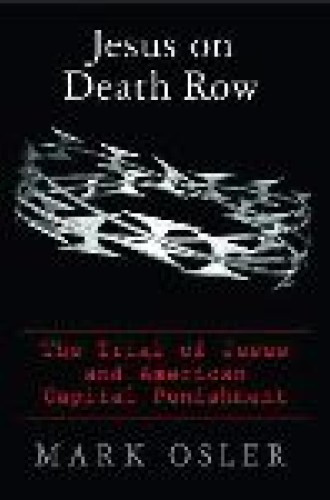Jesus on Death Row: The Trial of Jesus and American Capital Punishment
Karl Barth once asked a poignant question about capital punishment: “Now that Jesus Christ has been nailed to the cross for the sins of the world, how can we still use the thought of expiation to establish the death penalty?” With that in mind, I eagerly anticipated reading this book by Mark Osler, a professor of law at Baylor University and a former federal prosecutor. Osler wonders why American Christians, “who follow a religion whose central narrative is an execution,” continue to support a criminal justice system that involves procedures “remarkably similar to the process that Christ encountered.”
Osler draws on his professional experience (employing plenty of interesting anecdotes) and on the Gospel accounts to highlight the procedural parallels between the arrest, trial and execution of Jesus 2,000 years ago and those of people on death row in the U.S. today. From the investigation to the strategic arrest and the initial arraignment, from the trial to the last meal of the condemned person and the subsequent execution, Osler endeavors to show, “we treat our prisoners in the same way that Jesus was treated.”
To be sure, some parallels are fairly obvious: Judas’s betrayal of Jesus for 30 pieces of silver does resemble today’s use of confidential informants, who usually get paid and are therefore eager to help law enforcement. Other suggested similarities, however, seem more contrived. Osler points out that when Jesus was being arrested, one of his disciples cut off the ear of the high priest’s slave rather than that of the high priest. Similarly, it is the arresting officer, sometimes a “rookie cop,” who occasionally “takes a bullet” rather than the police chief or the prosecutor. Osler stretches this example to discuss the disproportionate use of the death penalty against poor and black defendants, when he might have made the same point by showing that the people who were executed by the Romans in Jesus’ time were mostly oppressed and poor.
Osler draws other parallels that seem artificial or forced. The chief priest tears his clothes and demands a verdict after hearing the testimony against Jesus; this is like a prosecutor using an emotional closing argument to sway a jury. Lethal injection “faintly traces the manner in which Christ was killed” in three ways: the anesthesia is like the wine and myrrh offered to Jesus; the pancuronium bromide used to paralyze the prisoner is like the nails that incapacitated Jesus on the cross; condemned prisoners today often die of asphyxiation because of the pancuronium bromide, before potassium chloride stops their heart, and asphyxiation “might have been the true cause of Christ’s death on the cross.”
That’s not all. Osler devotes a whole chapter to explaining how the Roman soldiers’ dividing up Jesus’ clothes was like law enforcement agencies receiving money when criminals are required to forfeit their possessions. Osler acknowledges that, “of course,” forfeiture is “distinct from the division of Jesus’ clothes.” Similar distinctions could be made with regard to most of the parallels he has identified. Events from the Gospel narratives function more as a springboard from which Osler can critically examine flaws in today’s legal procedures than they do as true parallels.
A related problem arises with Osler’s effort to harmonize the Gospels. Though he generally relies on Bible scholar Raymond Brown’s work, he admits that Brown would criticize him for forcing the Gospel narratives of Jesus’ arrest, trial and execution into a neat, stage-by-stage chronology. The book reminded me of end-times literature in which passages from Revelation are said to refer to helicopters, American presidents and the Trilateral Commission. Readers should keep in mind Osler’s disclaimer that he is not a theologian.
There are some places where Osler is on firmer ground. In one key chapter he provocatively reminds readers that the celebration of the Eucharist is rooted in “the last meal” of a man who would soon be executed. The meals that prisoners choose to eat before their execution are full of symbolism, offering glimpses into their humanity and personal identity. In these meals the “chasm between the murderer and Christ”—and us—is bridged. Here Osler is onto something theologically profound that deserves more than five pages of attention in the book.
The chapter on our imperfect legal system, which “inevitably leads to state executions of citizens who are, in fact, innocent,” is also compelling. According to the Death Penalty Information Center, 133 persons have been released from death row with evidence of their innocence since 1973, and many people and several states have recently begun to reconsider capital punishment. Osler asks, “If we choose to worship an innocent who was executed as a criminal, shouldn’t we care about the execution of innocents in our time?”
Not everyone will be persuaded by this argument. Supreme Court justice Antonin Scalia stated in 2006 that there is no “single verifiable case to point to” that proves that an innocent person has been executed, and that although no criminal justice system can completely rule out “the possibility that someone will be punished mistakenly,” the likelihood of this happening in the U.S. has been “reduced to an insignificant minimum.” How is the execution of even one innocent person considered insignificant? Positions like Scalia’s show us how crucial it is to muster a deeply theological argument—anchored in core Chris tian practices and beliefs—against state-sanctioned killing of persons, innocent and guilty alike.
Jesus on Death Row fell short of my expectations. Osler starts out with a creative insight brimming with theological import, but the book is, sadly, poorly executed.





